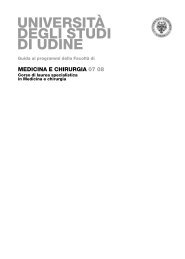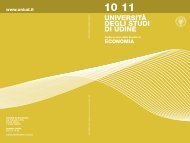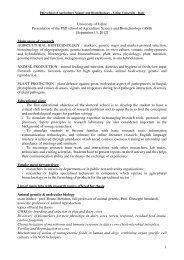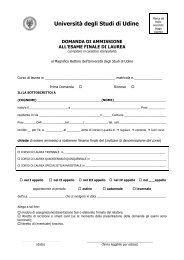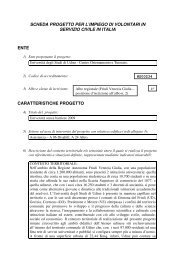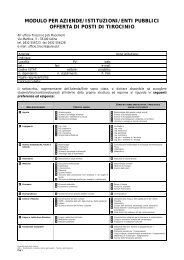â¢GUIDA ECONOMIA 07-08 - Università degli studi di Udine
â¢GUIDA ECONOMIA 07-08 - Università degli studi di Udine
â¢GUIDA ECONOMIA 07-08 - Università degli studi di Udine
You also want an ePaper? Increase the reach of your titles
YUMPU automatically turns print PDFs into web optimized ePapers that Google loves.
prospectus u<strong>di</strong>ne<br />
167<br />
ACCOUNTING 2<br />
Prof. Eugenio Comuzzi<br />
Aims<br />
The aim of the course is to provide the<br />
basic concepts on constructing and interpreting<br />
Italian annual financial reports.<br />
In particular, the course will analyse the<br />
principles, the methodologies and the<br />
tools used by lea<strong>di</strong>ng managers and<br />
accountants when compiling the annual<br />
report.<br />
Contents<br />
1. Measuring enterprise performance. Some<br />
introductory notes.<br />
The meaning of measurement and performance.<br />
Suggested processes and models<br />
to measure performance and con<strong>di</strong>tions.<br />
2. Performance measurement and annual<br />
reporting. Purpose and main principles.<br />
Annual financial reports. Purposes, characteristics,<br />
targets, techniques. Accounting<br />
literature; Italian and International<br />
accounting statements, civil law and tax<br />
law.<br />
3. Performance measurement and annual<br />
reporting. Application framework and<br />
reporting standards.<br />
Income statements and balance sheets:<br />
general and specific features.<br />
4. Performance measurement and annual<br />
reporting. Application framework, specific<br />
evaluation criteria and accounting policies.<br />
Evaluation criteria and accounting policies:<br />
property, plant and equipment,<br />
investment properties, intangible assets,<br />
inventories, receivables from trade customers<br />
and borrowers, cash and cash<br />
equivalents, equity, liabilities and provisions.<br />
5. Performance measurement and annual<br />
reporting. System outlook.<br />
Main principles and main departures<br />
from the rules.<br />
6. Stakeholder <strong>di</strong>sclosure.<br />
Public and voluntary <strong>di</strong>sclosure: obligations,<br />
benefits and limits.<br />
7. Workshop<br />
Case <strong>stu<strong>di</strong></strong>es, project work, encounters<br />
with entrepreneurs and CFOs.<br />
Pre-requisites<br />
Business Economics, Accounting 1.<br />
Bibliography<br />
References to books, papers, reviews and<br />
specific web sites will be recommended at<br />
the beginning and during the course.<br />
Some materials are available on the web<br />
at http://www.eugeniocomuzzi.it<br />
Exam<br />
A written examination and, possibly, an<br />
oral test. A pre-test may be set during the<br />
course.<br />
ACTUARIAL MATHEMATICS<br />
Prof.ssa Laura Ziani<br />
Contents<br />
- Life insurance companies<br />
An introduction to the role of life insurance<br />
companies as financial interme<strong>di</strong>aries.<br />
- Tra<strong>di</strong>tional life insurance contracts<br />
Endowment.<br />
Annuities.<br />
Term Insurance.<br />
Mixed Insurances.<br />
- Computation of Net premiums of tra<strong>di</strong>tional<br />
life insurance contracts<br />
Present value.<br />
Estimating probabilities of death and survival.<br />
Net single premium.<br />
Net annual premiums.<br />
Commutation Functions.<br />
- The mathematical reserve<br />
Forward Reserve.<br />
Recursive Reserve.<br />
Risk and Savings Premiums.




